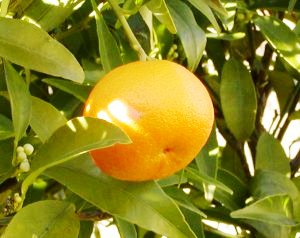Mandarin orange
The Mandarin orange, also known as the mandarin or mandarine (both lower-case), is a small citrus tree (Citrus reticulata) with fruit that looks like other oranges. Mandarin oranges are usually eaten plain or in fruit salads. The mandarin is tender, and is damaged easily by cold. It can be grown in tropical and subtropical areas.
| Mandarin orange | |
|---|---|

| |
| Scientific classification | |
| Kingdom: | |
| (unranked): | |
| (unranked): | |
| (unranked): | |
| Order: | |
| Family: | |
| Genus: | |
| Species: | C. reticulata
|
| Binomial name | |
| Citrus reticulata | |
Mandarin oranges contain many nutrients but is highest in vitamin C and calcium. A medium mandarin contains approximately 22 grams of vitamin C and 31 grams of calcium.
The mandarin is easily peeled with the fingers, and can be easily split into even segments without squirting juice. This makes it more convenient to eat, as utensils are not required to peel or cut the fruit. Mandarin segments are also sold in cans.
During Chinese New Year, Mandarin oranges and tangerines are considered traditional symbols of good fortune. During the two-week celebration, they are frequently displayed as decoration and presented as gifts to friends, relatives, and business partners.
Production volume

| Tangerines, mandarins, clementines Top ten producers in 2007 (1000 tonnes) | |
|---|---|
| 15,185 | |
| 1,974 | |
| 1,206 | |
| 1,066 | |
| 1,042 | |
| 778 | |
| 748 | |
| 744 | |
| 702 | |
| 670 | |
| 640 | |
| All other | 4,156 |
| World total | 27,869 |
| Source: UN Food & Agriculture Organisation (FAO), [1] Archived 2016-10-16 at the Wayback Machine | |
Mandarin Orange Media
Fruiting mandarin tree in Crete
Dried mandarin peel used as a seasoning
Chocolate flavoured with Mandarine Napoléon
References
Other websites
| Wikimedia Commons has media related to Lua error in Module:Commons_link at line 62: attempt to index field 'wikibase' (a nil value).. |
| Wikispecies has information on: Citrus reticulata. |






